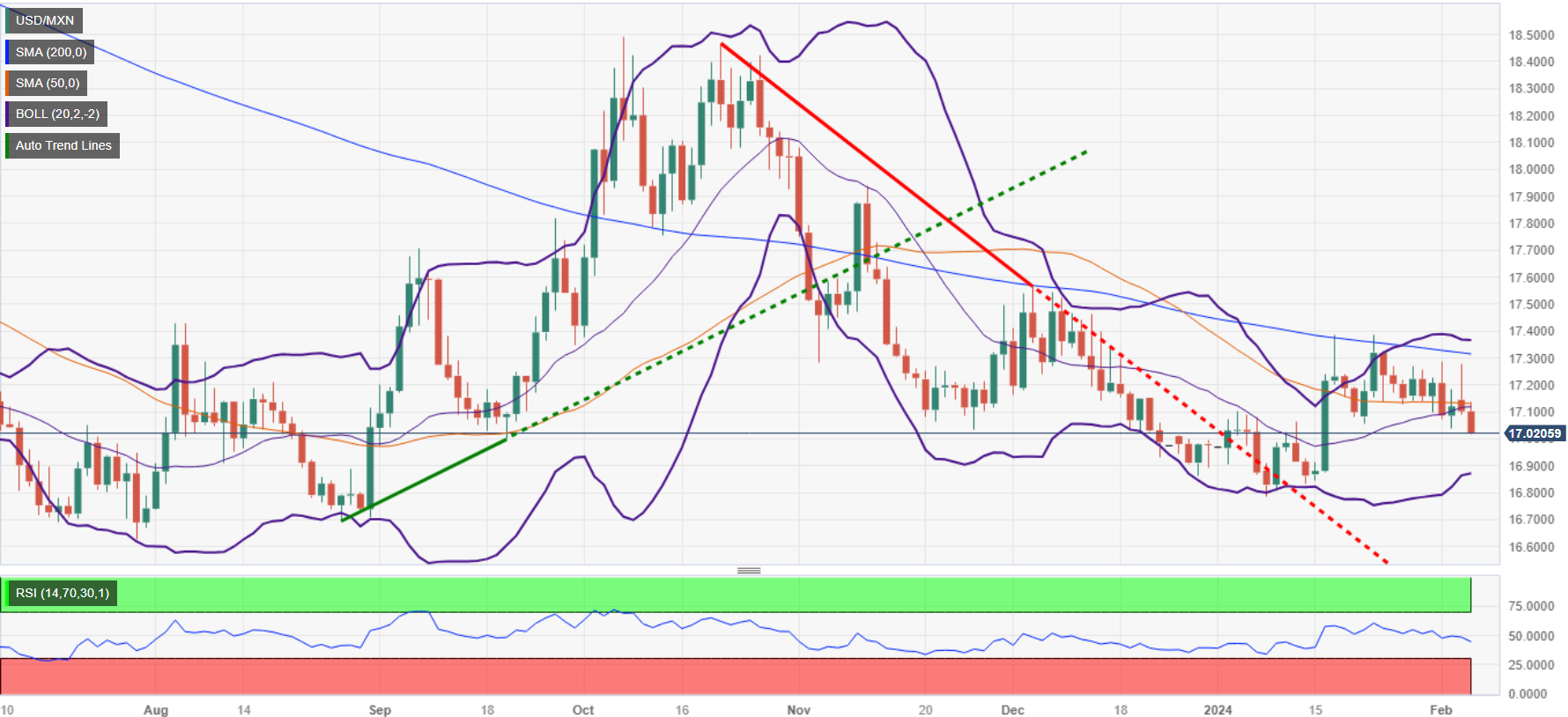Mexican Peso gains on US Dollar amid risk-on mood, falling US yields
- Mexican Peso gains, driven by a soft US Dollar due to lower US Treasury yields and upbeat market mood.
- Market anticipates Consumer Confidence, auto data and Banxico's rate decision.
- Powell's rate cut remarks prompt cautious trading; speeches by Fed's Mester, Kashkari, Collins in focus.
The Mexican Peso (MXN) advanced against the US Dollar (USD) in early trading during the North American session as US Treasury bond yields edged lower, a headwind for the Greenback. A risk-on impulse, as witnessed by Wall Street posting gains, is a tailwind for the Mexican currency. Traders await inflation figures and the Bank of Mexico (Banxico) monetary policy meeting on Thursday. The USD/MXN exchanges hands at 17.01, down 0.54%.
Mexico´s economic calendar will gather some steam on Wednesday with the release of Consumer Confidence data. Then automobile industry data arrives on Wednesday. By Thursday, Banxico will get an early update on inflation ahead of their decision. The central bank will hold rates unchanged, most analysts predict.
Meanwhile, Federal Reserve (Fed) Chair Jerome Powell said the US central bank is in no rush to cut rates, instead reassuring the majority of Fed officials to expect three rate cuts. Ahead in the day, traders will get cues from Loretta Mester, Neil Kashkari and Susan Collins.
Daily digest market movers: Mexican Peso gathers traction awaiting crucial inflation data
- Mexico´s economic docket on Wednesday:
- Consumer Confidence was 46.8 in December, worse than November’s reading.
- Auto Exports were virtually unchanged at 16% YoY.
- Auto Production decreased in December by -9.9%.
- Mexico´s Consumer Price Index (CPI) in January is expected to rise from 0.71% to 0.88% MoM, while annual figures are foreseen at 4.88%, up from 4.66%.
- The US economy remains resilient after the first batch of data was released in February. Stronger-than-expected PMIs and a hot Nonfarm Payrolls report paint an optimistic outlook for the economy.
- Neil Kashkari commented that a strong economy means the Fed is in no hurry to make interest rate cuts. Kashkari acknowledged that inflation is making “rapid progress” toward the Fed’s 2% target and added that policy could not be sufficiently restrictive.
- Chicago Fed President Austan Goolsbee noted that inflation could remain falling amid a strong US economy,
- S&P Global comments about Mexico:
- Confirmed Mexico´s BBB foreign currency rating and BBB+ local currency long-term debt rating.
- Affirmed that stable macroeconomic conditions, with real growth in Gross Domestic Product above 3% in 2023, is supported by solid domestic demand and moderating inflation.
Technical analysis: Mexican Peso surges threatening to conquer the crucial 17.00 mark
The USD/MXN shifted from neutral to downward biased once it fell below the 50-day Simple Moving Average (SMA) at 17.12, which opened the door for further losses. A breach of that level exposed strong support, as seen at 17.05. Further downside is seen at the psychological 17.00 figure, followed by the current year-to-date low of 16.78.
On the other hand, if buyers reclaim the 50-day SMA, that can pave the way to test the 200-day SMA at 17.31. Upside risks emerge once that barrier is cleared. The next real resistance comes at 17.40, the 100-day SMA.
USD/MXN Price Action – Daily Chart

Mexican Peso FAQs
What key factors drive the Mexican Peso?
The Mexican Peso (MXN) is the most traded currency among its Latin American peers. Its value is broadly determined by the performance of the Mexican economy, the country’s central bank’s policy, the amount of foreign investment in the country and even the levels of remittances sent by Mexicans who live abroad, particularly in the United States. Geopolitical trends can also move MXN: for example, the process of nearshoring – or the decision by some firms to relocate manufacturing capacity and supply chains closer to their home countries – is also seen as a catalyst for the Mexican currency as the country is considered a key manufacturing hub in the American continent. Another catalyst for MXN is Oil prices as Mexico is a key exporter of the commodity.
How do decisions of the Banxico impact the Mexican Peso?
The main objective of Mexico’s central bank, also known as Banxico, is to maintain inflation at low and stable levels (at or close to its target of 3%, the midpoint in a tolerance band of between 2% and 4%). To this end, the bank sets an appropriate level of interest rates. When inflation is too high, Banxico will attempt to tame it by raising interest rates, making it more expensive for households and businesses to borrow money, thus cooling demand and the overall economy. Higher interest rates are generally positive for the Mexican Peso (MXN) as they lead to higher yields, making the country a more attractive place for investors. On the contrary, lower interest rates tend to weaken MXN.
How does economic data influence the value of the Mexican Peso?
Macroeconomic data releases are key to assess the state of the economy and can have an impact on the Mexican Peso (MXN) valuation. A strong Mexican economy, based on high economic growth, low unemployment and high confidence is good for MXN. Not only does it attract more foreign investment but it may encourage the Bank of Mexico (Banxico) to increase interest rates, particularly if this strength comes together with elevated inflation. However, if economic data is weak, MXN is likely to depreciate.
How does broader risk sentiment impact the Mexican Peso?
As an emerging-market currency, the Mexican Peso (MXN) tends to strive during risk-on periods, or when investors perceive that broader market risks are low and thus are eager to engage with investments that carry a higher risk. Conversely, MXN tends to weaken at times of market turbulence or economic uncertainty as investors tend to sell higher-risk assets and flee to the more-stable safe havens.

